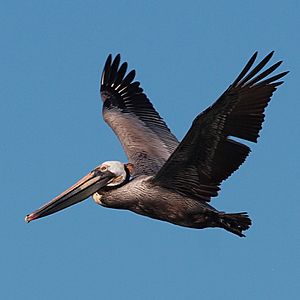Vandenberg State Marine Reserve facts for kids
The Vandenberg State Marine Reserve (SMR) is a special ocean area that protects marine life. It's located off the coast of Vandenberg Air Force Base, near a city called Lompoc in central California. This protected area covers about 32.84 square miles (85.05 square kilometers) of ocean. In the Vandenberg SMR, all living things in the ocean are safe. This means no one is allowed to fish or take any marine animals or plants from this area.
Contents
Protecting Our Oceans: A Look at Vandenberg SMR
The Vandenberg SMR was created in September 2007. It was set up by the California Department of Fish & Wildlife. This reserve was one of the first 29 marine protected areas made during a big project called the Marine Life Protection Act Initiative. This project is a team effort involving many people. Its goal is to create a network of protected ocean areas all along California's coast. This helps keep our ocean healthy for the future.
Ocean Homes and Amazing Animals
The Vandenberg area has different kinds of ocean homes for animals. You can find rocky reefs and sandy areas. There are also tall, rocky cliffs along the coast. These cliffs are very important nesting spots for many seabirds. Birds like guillemots, cormorants, and oystercatchers build their nests here.
Scientists have studied this area a lot. They have found many different kinds of fish and small ocean creatures like crabs and snails. These animals live in the reefs and sandy bottoms. Scientists also watch how these smaller animals interact with bigger animals. For example, they study how seabirds and marine mammals use this area to find food.
Fun Things to Do and Places to Visit
California's marine protected areas are great places to enjoy the ocean. They encourage fun activities and learning. Just north of Vandenberg SMR, you'll find Point Sal State Beach. This park has 80 acres (32 hectares) of land and 1.5 miles (2.4 kilometers) of oceanfront. To the south, there's Gaviota State Park. It's a popular spot for swimming, fishing (outside the reserve), and camping.
Inside the marine reserve, you can still do many exciting things. Activities like kayaking, diving, snorkeling, and swimming are usually allowed. These activities let you explore the ocean's beauty up close, without harming the protected marine life.
Scientists at Work: Studying the Ocean
Scientists are actively monitoring some of California's protected ocean areas, including those near Vandenberg. They do this to see how well these areas are working to protect marine life. They also learn more about the overall health of the ocean. For example, similar studies in protected areas near the Santa Barbara Channel Islands have shown good results. Over time, scientists have seen fish grow bigger and become more numerous in those areas.
Many universities and research groups help with this important work. Some of them include Stanford University’s Hopkins Marine Station, University of California Santa Cruz, Moss Landing Marine Laboratories, and Cal Poly San Luis Obispo. Scientists use different methods to study the ocean. They might use hook-and-line sampling (catching and releasing fish), or they might dive underwater to survey the animals and plants. They also use special underwater robots called Remote Operated Vehicles (ROVs) to explore deeper parts of the ocean.


